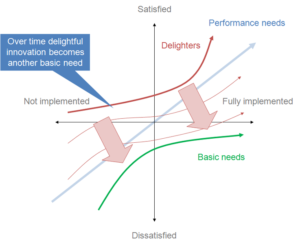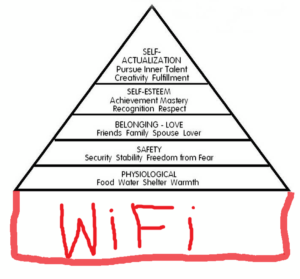I started writing this blog post over a week ago, but it stalled as I was hitting a bit of a mental wall with it. But then I saw this tweet, which summed it up nicely.
Just because people do things badly doesn’t make the thing bad.
Agile
OKRs
Design Sprints
insert thing here.
Some people resist complexity.— christina (@cwodtke) October 24, 2017
Just add “Delight” or “Delighters” to the bottom of that list. I’ve been feeling a lot of backlash from the UX world against them, which isn’t vastly surprising given the amount of complete hogwash which has been vomited forth about them.
But it does bug me. It’s another example of people who don’t really understand domain-specific terminology latching onto it, unwittingly abusing it… and then the “experts” deciding to blame the terminology and models instead of stepping back and thinking “how can we help people grok this better?”
The Kano Model is at the core of this terminology, but Maslow’s Hierarchy of Needs is a handy reference too.
The Kano Model

The Kano Model, Showing Change over Time.
Image By Craigwbrown (Own work)
CC BY-SA 3.0,
via Wikimedia Commons
But Dr. Noriaki Kano didn’t use the word “Delighter” originally, as far as I can tell. The paper it’s all based on [Kano, N., Seraku, N., Takahashi, F., and Tsuji, S. 1984. “Attractive quality and must-be quality,” Journal of the Japanese Society for Quality Control (14:2), pp 147-156] uses “Attractive Quality”, and is mostly focussed on the following:
- Attractive qualities give a satisfaction boost if they’re present, but their absence doesn’t cost anything.
- Performance qualities give a satisfaction boost if strong but have a satisfaction cost if they’re weak.
- Must-have qualities lower satisfaction if they’re not present, but their presence doesn’t give a boost.
- Features move down that list over time. Attractive qualities gradually become performance qualities and then must-have qualities as they become more common and more people just expect them to be there.
I think the words “Delight” and “Delighter” were brought in later as a way to clarify what is meant by an attractive feature, but I could be wrong about that. I’ve been unable to actually get hold of the original article to check – so apologies to Dr Kano if that’s incorrect.
The Problem
Before its use in UX land, I understand that the word “delight” in this context came from the hospitality business. It came from the idea that just doing what was expected wasn’t enough to stand out. Nor was doing all the typical “we’re a classy hotel” optional extra things because all the other classy hotels did them too. You had to do everything which was expected by default, then do everything which might be considered as optional and then do something extra – something above and beyond.
The “bit more” on its own doesn’t cut it. You’ve still got to do all the stuff before it. If you haven’t covered off the baseline stuff, it’s wasted effort and adds insult rather than delight.
It’s like building a ladder with only a top rung: of course it’s useless. It shows a fundamental misunderstanding of both the goal and the Kano Model. But that ladder is exactly what I keep seeing built, and then I hear complaints that blame the Kano Model and its delighters for it.
A fair number of people just saw the words “delighter” or “delight” and latched onto it, focusing on trying to create delight to the exclusion of all else. Because that always ends well.
The problem is that if all you have are delighters or attractive qualities, you’re in a situation where you have none of the other stuff. I can assure you, whatever your designing, there will be some of the must-have qualities you are missing.
Think about the pyramid view of Maslow’s Hierarchy of Needs (with or without the popular additional “wifi” layer – this works either way). This is a somewhat related idea. That hierarchy works on the basis that the lower down needs must be satisfied before the higher up needs become meaningful, stable or sustainable. Maslow’s idea was that the lower layers must be fully met before the higher layers can be achieved – without them, the pyramid collapses.
That idea is baked-in with the Kano Model too. The satisfaction gained from one or two delighters or attractive qualities being present will be massively undermined by the absence of all of the must-have qualities and performance qualities.
Fancy wine with a personalised label and a box of chocolates might be a nice touch in your hotel room, but if the room is covered in faeces and crawling with cockroaches then it isn’t going to make your stay delightful. It’s going to be insulting.
It’s only a delighter when placed in the context of everything else that might be considered having also been done! Without that context, it’s just an inadequate attempt at a bribe.
But what really gets my goat…
It’s not really that exclusive focus on delight that annoys me, although it certainly doesn’t help. That’s just the problem of a buzzword-heavy discipline which, on a superficial level, looks like an easy way to make a buck.
The UX industry will always attract people who’ll exploit the gullible by throwing buzzwords at them in exchange for money. They bug me, but what bugs me more is the misguided backlash from the people in the industry who should know better. The backlash against the models and techniques that are being abused and misapplied, whose names are being taken in vain.
I’m starting to see and hear UXers in positions of authority denigrating the Kano Model for being focused on the frivolous idea of “delight” to the exclusion of all else.
I don’t like it when people who don’t know the origins or meaning of domain-specific terminology muddle it with casual language. It leads to a watering-down of ideas. But I understand it and understand why it happens. You fix it by explaining and sharing understanding. At a minimum, you just suck it up and cater for the terminology difference by using the appropriate terms for each audience.
But the backlash against the model itself because people don’t bother to properly understand it? Nope. Let’s just stop doing that, please.
Let things be things
The Kano Model is a model. It’s a simplified abstraction. It’s a useful model, but that’s all it is. While it’s useful, it’s not a world-encompassing ideology. It’s a tool. I strongly suspect it didn’t come around to your house and force it’s filthy delighters into your face, shouting “DELIGHT! DELIGHT!”.
People who didn’t know better did that bit (not literally, I hope).
We can train most of those people out of abusing the models and terminology. We might even end up with more good designers as a result. But if we blame the models and terminology and steer people away from using them instead of understanding and explaining them better, we might as well give up and all go home.
Let’s not do that. Let’s just learn, use and teach our tools better.

Recent Comments